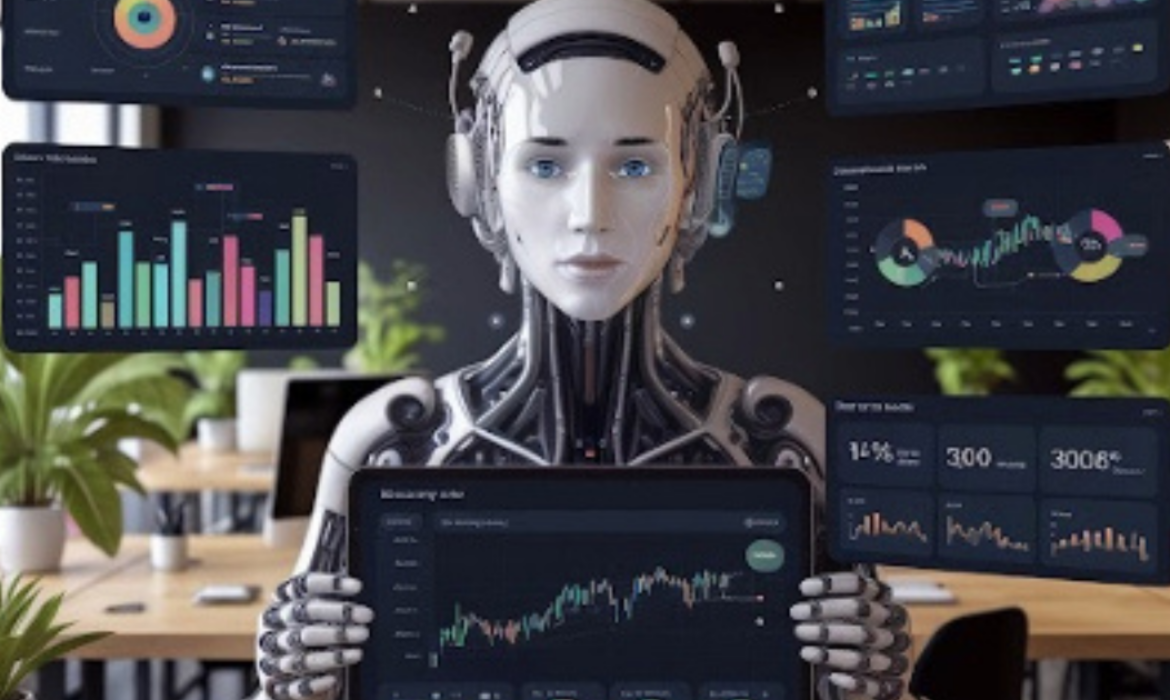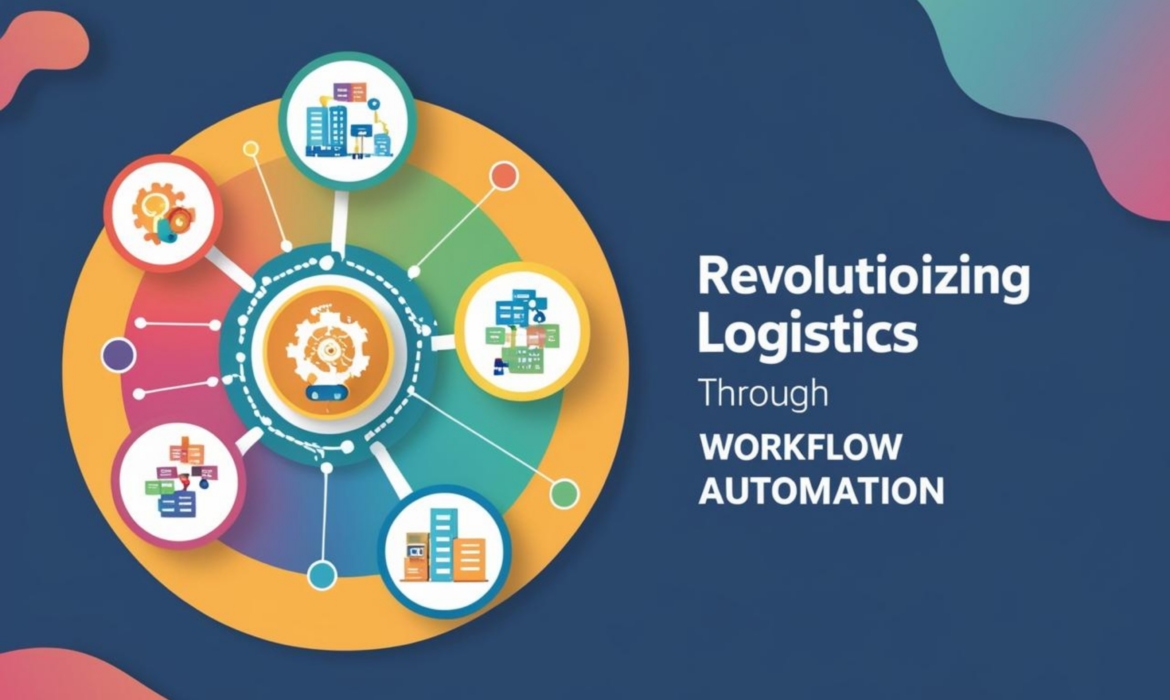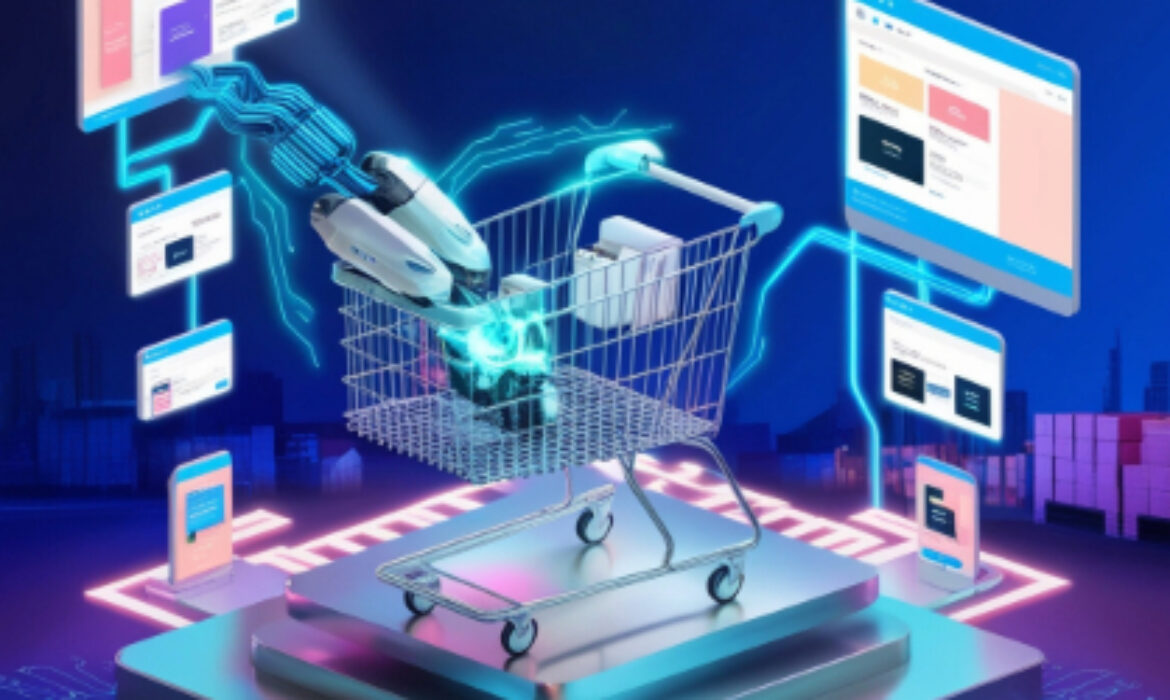Harnessing AI: A Strategic Advantage For Today’s Business Leaders
In today’s fast-paced digital economy, artificial intelligence is no longer a futuristic concept – it’s a present-day differentiator. Forward-thinking leaders are increasingly viewing AI not just as a tool, but as a strategic imperative that drives efficiency & innovation.
AI-Powered Workflow Automation For Healthcare Efficiency
In an era where healthcare organizations are expected to deliver faster, more personalized care with tighter budgets & fewer resources, operational efficiency is no longer a luxury; it’s a necessity.
Revolutionizing Logistics Through Workflow Automation Success
Understanding Workflow Automation in Logistics
Workflow automation is rapidly transforming logistics, promising smoother operations from warehouse to doorstep. Early efforts focused on automating inventory and order processing through basic software and manual data entry. Key advancements like barcode scanners, RFID tags, and warehouse management systems (WMS) then enabled real-time tracking and improved inventory control, setting the stage for more comprehensive strategies.
Today, artificial intelligence (AI), machine learning (ML), and robotic process automation (RPA) are propelling further change. AI analyzes data to predict demand and optimize routes, while ML continuously refines workflows. RPA handles repetitive tasks like data entry and invoicing. This tech-driven shift is enhancing efficiency, accuracy, and responsiveness, reshaping the logistics landscape, and paving the way for future innovations.
Key Benefits of Automation for Supply Chains
Improved Efficiency and Productivity
One of the primary advantages of automation in supply chains is the significant boost in efficiency and productivity. Utilizing automated systems such as robotic process automation (RPA) and AI-driven analytics, businesses can streamline their operations and reduce the time required to complete tasks. By alleviating operational bottlenecks, teams can shift their focus from mundane, repetitive tasks to more strategic decision-making processes.
Cost Savings and Resource Optimization
Automation offers considerable cost savings by minimizing the reliance on labor and enhancing resource utilization. It mitigates human errors and improves inventory management through precise forecasting, enabling companies to avoid costly mistakes and issues related to overstocking. This heightened efficiency not only contributes positively to the overall financial performance but also allows for reinvestment in further innovations.
Enhanced Accuracy and Customer Satisfaction
The implementation of automation within supply chain operations dramatically increases accuracy, leading to a substantial reduction in human error. Improvements in order fulfillment and inventory tracking directly boost customer satisfaction, as orders are processed more accurately and delivered on time. Additionally, real-time updates on inventory levels and order statuses further enhance the customer experience.
Scalability and Adaptability
Automation equips businesses with vital scalability and adaptability in an ever-changing market. Automated systems can rapidly adjust to shifting demands, allowing businesses to remain agile without placing excessive strain on resources. This level of flexibility not only supports ongoing competitiveness but also promotes sustainable practices by optimizing resource utilization throughout the entire supply chain lifecycle.
Technologies Driving Workflow Automation Forward
Workflow automation is significantly propelled by several key technologies that enhance operational efficiency and streamline processes. One pivotal technology is Robotic Process Automation (RPA), which automates repetitive tasks, allowing employees to focus on more strategic activities. By integrating RPA with Artificial Intelligence (AI) and Machine Learning (ML), organizations can achieve hyper-automation, where complex, end-to-end processes are automated, driving higher productivity and adaptability to business needs. Cloud-based platforms also play a crucial role by providing accessible, scalable, and flexible solutions that allow businesses to implement automation without extensive infrastructure investments.
Additionally, advancements in integration technologies, such as Application Programming Interfaces (APIs) and low-code/no-code development platforms, facilitate seamless connectivity between various software applications and systems. This integration enables data flow across departments, enhancing collaboration and decision-making. Essential tools like AI-driven analytics further enable businesses to gain insights from operational data, optimizing workflows and improving overall process accuracy. Collectively, these technologies not only drive automation forward but also empower organizations to be more agile and responsive in today’s rapidly evolving market.
Challenges & Best Practices in Automated Workflow Adoption
Adopting automated workflow solutions comes with significant benefits, such as improved efficiency, reduced manual errors, and streamlined operations. However, organizations often face challenges, including resistance to change, integration complexities with existing systems, and high initial implementation costs. Additionally, ensuring data security, maintaining regulatory compliance, and training employees to adapt to new automated processes can be daunting. Without proper planning, businesses may struggle with workflow disruptions and limited scalability.
To successfully implement automation, organizations should follow best practices such as conducting a thorough assessment of existing workflows, selecting the right automation tools, and ensuring seamless integration with current systems. Prioritizing employee training and change management can help ease the transition and encourage adoption. Additionally, businesses should continuously monitor and optimize automated workflows to enhance performance and address evolving needs. By taking a strategic approach, companies can maximize the benefits of workflow automation while minimizing potential roadblocks.
Future Trends: The Next Phase of Workflow Automation in Logistics
The future of workflow automation in logistics is being influenced by several key trends. Artificial Intelligence (AI) and Machine Learning are significantly improving decision-making and demand forecasting, which results in enhanced operational efficiencies. The emergence of robotics and autonomous systems, including drones and automated guided vehicles (AGVs), is transforming warehouse operations and last-mile delivery, effectively addressing labor shortages and expediting processes.
In addition, the Internet of Things (IoT) enhances connectivity by offering real-time data on inventory levels and shipment statuses, allowing for proactive adjustments that boost efficiency. Cloud-based solutions are reshaping logistics management, enabling smooth collaboration, and providing real-time updates across all stakeholders involved. There is also an increasing emphasis on sustainability, with companies utilizing automation to optimize delivery routes and adopt environmentally friendly practices. Finally, blockchain technology is becoming more prevalent as it enhances transparency and security within logistics, offering a decentralized ledger that tracks shipments and verifies transactions, thereby reducing fraud and fostering trust among partners.
Navigating Workflow Automation in the Insurance Landscape
Efficiency is crucial in today’s fast-paced industries, and this principle holds special significance in the insurance sector. As organizations face mounting pressure to enhance their operational effectiveness, workflow automation is taking center stage. By transforming complex processes into seamless operations, automation reduces the likelihood of manual errors and optimizes workflows. This shift allows insurance professionals to redirect their focus from tedious administrative tasks to what truly matters—delivering exceptional client service. As competition grows fiercer and customer expectations evolve, integrating these technologies becomes not just an option but a necessity for survival and growth.
Moreover, the adoption of workflow automation enables insurance companies to maintain agility in an ever-changing market. With streamlined processes, organizations can respond more quickly to client inquiries, adapt to regulatory changes, and implement new products and services with ease. This not only enhances internal productivity but also leads to higher levels of customer satisfaction. As insurers navigate this transformation, embracing automation will be key to staying competitive, meeting the demands of modern consumers, and thriving in an increasingly complex industry landscape.
Understanding Workflow Automation: Key Concepts for Insurance Professionals
Workflow automation involves using technology to streamline and enhance business processes, enabling tasks to be completed with minimal human intervention. In the insurance sector, this can encompass critical functions like policy management, claims processing, and customer engagement. By transitioning to digital workflows, insurance companies can significantly boost their operational efficiency, reduce errors, and enhance service quality. For professionals looking to remain competitive in this ever-evolving landscape, a strong understanding of these fundamental concepts is essential. As data analytics increasingly impacts insurance operations, grasping automation allows professionals to leverage technology effectively, leading to notable improvements in service delivery.
Benefits of Workflow Automation in Insurance Operations
Workflow automation offers a wide array of benefits for insurance operations. By automating repetitive tasks, companies can significantly improve efficiency and shorten processing times—both critical in today’s competitive environment. Automation minimizes errors, resulting in increased accuracy for policy management and claims processing, which are vital for boosting customer satisfaction. Clients value quick responses and reliable information, making automated workflows a strategic advantage for employees and beneficial for customers seeking timely resolutions. Recognizing and embracing these benefits is crucial for any innovative insurance provider striving for growth.
Common Challenges in Implementing Automation and How to Overcome Them
While implementing workflow automation can yield substantial benefits, it also presents unique challenges. Employees may resist changes due to fears of job loss or because they struggle to adapt to new technologies. Moreover, integrating automation into existing workflows—especially in areas like policy and claims management—can be complex and require significant upfront investment. These barriers can be overcome through comprehensive training and involving employees in the automation process. Providing robust support and clearly communicating the advantages of automation, combined with a gradual implementation strategy, can foster a culture of innovation and facilitate a smoother transition for all.
Essential Tools and Technologies for Effective Workflow Automation
Successful automation in the insurance industry relies on utilizing the right tools and technologies. Solutions such as robotic process automation (RPA), business process management (BPM) software, and customer relationship management (CRM) systems are crucial for streamlining processes from policy management to claims handling. Data analytics also plays a transformative role, helping insurers uncover trends and enhance operational efficiency. These technologies ensure smooth information flow and bolster data management capabilities. By investing in user-friendly and scalable automation tools, organizations can remain agile and responsive to changing market demands.
Best Practices for Integrating Automation into Insurance Processes
To successfully integrate automation into insurance processes, thoughtful planning and execution are vital. Start by identifying the specific workflows—such as claims processing and customer engagement—that will benefit most from automation. Involve key stakeholders in the planning phase to gather insights that can enhance buy-in and standardize support efforts. Implementing automation in stages allows companies to adjust to changes more comfortably. Regularly reviewing and refining automated processes is crucial for maintaining efficiency and empowering customers. By following these best practices, insurance companies can fully realize the benefits of automation initiatives and improve service delivery.
Future Trends: The Evolving Role of Automation in the Insurance Industry
As technology continues to advance, the role of automation in the insurance industry is set to expand significantly. Innovations like artificial intelligence (AI) and machine learning are becoming key components of automated workflows, enabling advanced data analytics for predictive insights and personalized customer interactions. Growing regulatory compliance requirements are driving the need for sophisticated automation tools to ensure adherence to industry standards. Insurers who stay ahead of these emerging trends and invest in the necessary technologies will enhance their operations and secure a competitive advantage in a rapidly changing market, ultimately leading to greater customer engagement and empowerment.
Automating Customer Service: The Role of AI in Modern Contact Center
Imagine a world where customer service inquiries are resolved instantly and available 24/7, eliminating the frustration of waiting on hold. As customer expectations grow in today’s fast-paced digital landscape, organizations are increasingly looking for innovative solutions to enhance efficiency and satisfaction. Automating customer service has emerged as a key strategy in this evolution, with artificial intelligence (AI) at the forefront of modern contact centers.
AI technologies, including chatbots, natural language processing, and predictive analytics, empower businesses to streamline their operations, reduce response times, and deliver personalized experiences. By adopting these AI-driven solutions, companies are transforming the way they interact with customers and setting new standards for service excellence. This shift not only drives greater customer loyalty but also enhances overall operational effectiveness, ensuring that businesses remain competitive in an ever-changing market.
The Evolution of Contact Centers: From Manual to AI-Driven Operations
The transformation of contact centers has shifted from traditional manual processes to sophisticated AI-driven systems. In the past, human agents handled customer inquiries over the phone, often resulting in long wait times and inconsistent service due to high call volumes. While automatic call distribution and interactive voice response (IVR) technologies improved efficiency, they still relied heavily on human involvement, demonstrating the need for greater automation in customer service.
Currently, AI technologies have revolutionized contact centers by significantly enhancing customer experience and operational efficiency. By utilizing natural language processing, predictive analytics, and machine learning, contact centers can automate routine inquiries and provide personalized assistance around the clock through AI chatbots and virtual assistants. This shift allows human agents to focus on more complex issues, streamlining processes and improving response times, ultimately leading to higher customer satisfaction. As AI continues to evolve, contact centers are set to further enhance their capabilities, helping organizations succeed in a competitive environment.
Key AI Technologies Powering Modern Contact Centers
Modern contact centers are transforming customer service with AI-driven technologies. Natural Language Processing (NLP) empowers chatbots and virtual assistants to understand and engage in human-like conversations. These intelligent tools efficiently handle inquiries, provide instant information, and complete transactions without human intervention. By reducing wait times and automating routine tasks, AI enhances speed and accuracy in customer support. Voice and text interactions feel seamless, ensuring a smooth and engaging experience. As a result, businesses can deliver faster, more responsive service while optimizing resources.
Predictive analytics takes customer interactions to the next level by forecasting needs before they arise. By analyzing past data, AI helps agents proactively address issues like billing concerns or service disruptions. This foresight enables personalized interactions that improve customer satisfaction and loyalty. Real-time speech recognition and sentiment analysis further enhance quality assurance and agent performance. These AI capabilities refine training, ensuring teams are better equipped to handle complex requests. As AI evolves, it continues to revolutionize contact centers, making them more agile, intelligent, and customer-focused.
The Advantages of AI in Contact Centers: Cost Savings and Scalability
AI adoption in contact centers boosts cost efficiency and scalability by automating tasks like customer inquiries, transactions, and scheduling. This reduces workforce needs, cutting operational costs while optimizing workflow through intelligent call routing.
AI also enables seamless scaling to match fluctuating demand. During peak periods, AI chatbots efficiently manage surges, ensuring fast response times and consistent service quality. This adaptability enhances customer satisfaction and loyalty while helping businesses stay competitive, improve productivity, and respond swiftly to market changes.
Boosting Agent Productivity and Reducing Workload with AI
AI is revolutionizing workplace productivity by automating routine tasks like data entry, customer inquiries, and report generation. This allows agents to focus on complex issues requiring critical thinking and creativity, improving efficiency and service quality. AI chatbots handle basic queries, freeing up agents for more meaningful work that adds value to their organizations.
Additionally, AI-driven analytics provide real-time insights, helping agents make informed decisions and personalize customer interactions. By streamlining workloads and enhancing outcomes, AI empowers employees to maximize their skills while reducing repetitive tasks. As AI advances, it continues to create a more efficient, dynamic, and responsive workplace.
The Future of AI in Contact Centers: Trends and Innovations
AI is poised to transform contact centers by introducing chatbots and voice assistants that facilitate immediate automated responses. This enhances user experiences while allowing human agents to concentrate on complex issues, providing a more seamless service.
Moreover, AI advancements will improve operational efficiency in contact centers, optimizing processes and promoting better resource management and cost savings. Continuous innovations in AI technology will keep contact centers adaptable to customer needs, enabling businesses to enhance service capabilities and maintain a competitive edge in a fast-paced market.
DeepSeek-R1 Vs OpenAI: A Clash of Specialized and Versatile AI Models
The emergence of Deepseek, particularly its advanced reasoning model Deepseek R1, has sparked considerable debate within the tech community as it rapidly ascends to become a top-rated free app on the US Apple App Store. Renowned for its innovative application of large-scale reinforcement learning, Deepseek distinguishes itself from traditional AI leaders like OpenAI by delivering impressive results with a more efficient and cost-effective approach. While OpenAI reportedly poured over $100 million into developing its GPT-4 model, Deepseek claims to have achieved comparable breakthroughs in just two months for only $6 million. This stark contrast highlights a significant shift in the AI landscape towards open-source models that are increasingly capable of rivaling proprietary systems.
As Deepseek gains momentum, it is prompting a re-evaluation of established AI development strategies, emphasizing the potential for transformative outcomes through efficient resource utilization and innovative methodologies. The rise of open-source innovation is intensifying the competition with proprietary frameworks, ultimately reshaping the future of artificial intelligence and redefining the trajectory of technological advancement. The ongoing battle between these two approaches suggests a dynamic shift in how AI technologies may be developed and deployed in the coming years.
Why is DeepSeek a Game Changer?
DeepSeek’s emergence in the AI landscape coincides with a critical juncture amid the ongoing tech cold war between the U.S. and China. U.S. export controls on advanced technologies, particularly Nvidia chips, have severely restricted China’s access to cutting-edge AI hardware. Consequently, many Chinese companies have shifted their focus to developing downstream applications, relying on existing models rather than investing in foundational AI systems. This pivot has fostered dependency on Western technologies and created an innovation gap.
With DeepSeek’s rise, there is potential for a significant shift in this dynamic. The startup has demonstrated that substantial AI advancements can be achieved with far less investment than that of proprietary models like OpenAI’s GPT-4. By leveraging large-scale reinforcement learning and efficient resource management, DeepSeek challenges the belief that success in AI development is solely dependent on access to advanced hardware and vast financial resources. This approach not only opens the door for other players in constrained environments but also encourages a rethinking of global AI strategies, promoting open-source methodologies and community-driven initiatives over proprietary technology.
Cost Efficiency: The Economic Advantage of DeepSeek-R1
DeepSeek’s emergence in the AI landscape coincides with a critical juncture amid the ongoing tech cold war between the U.S. and China. U.S. export controls on advanced technologies, particularly Nvidia chips, have severely restricted China’s access to cutting-edge AI hardware. Consequently, many Chinese companies have shifted their focus to developing downstream applications, relying on existing models rather than investing in foundational AI systems. This pivot has fostered dependency on Western technologies and created a gap in innovation.
With DeepSeek’s rise, there is potential for a significant shift in this dynamic. The startup has demonstrated that substantial AI advancements can be achieved with far less investment than that of proprietary models like OpenAI’s GPT-4. By leveraging large-scale reinforcement learning and efficient resource management, DeepSeek challenges the belief that success in AI development is solely dependent on access to advanced hardware and vast financial resources. This approach not only opens the door for other players in constrained environments but also encourages a rethinking of global AI strategies, promoting open-source methodologies and community-driven initiatives over proprietary technology.
OpenAI’s Multifunctional AI Development Strategy
OpenAI’s strategy for AI development focuses on creating versatile, multifunctional models such as GPT-4, capable of addressing a broad spectrum of tasks, including natural language processing and problem-solving in various fields. However, this level of flexibility comes with a significant price tag. OpenAI has reportedly invested over $100 million in the development of GPT-4, a substantial expenditure aimed at ensuring the model performs well across diverse applications. Yet, these high costs can pose barriers to accessibility for smaller competitors.
Despite the cutting-edge nature of OpenAI’s models, their resource-intensive requirements have ignited discussions regarding sustainability and efficiency. As the demand for specialized and cost-effective AI solutions rises, OpenAI’s focus on multifunctionality may encounter competition from more streamlined and affordable alternatives, such as DeepSeek.
Performance Comparison: A Comparative Analysis
Mathematical Reasoning and Coding Tasks
DeepSeek-R1 has shown superior performance in mathematical reasoning and coding tasks, achieving a notable 79.8% accuracy on the AIME 2024 benchmark, slightly outperforming OpenAI’s models which achieved 79.2%.
Versatility and General-Purpose Capabilities
OpenAI’s models, like GPT-4, are celebrated for their versatility and proficiency across a wide array of tasks. They excel in natural language understanding, translation, and creative writing.
Multitask Language Understanding
In the Massive Multitask Language Understanding (MMLU) benchmark, OpenAI’s models have demonstrated higher accuracy rates than DeepSeek-R1, highlighting their extensive knowledge base and competence in diverse subjects.
Future Trends: What Lies Ahead for AI Models
The future of AI models is set for a transformative shift, driven by key trends shaping the industry. Multimodal AI, which integrates text, images, audio, and video, is emerging as a game-changer, enabling more natural interactions and improving accuracy. This evolution toward versatile AI systems will redefine their role in daily life and business operations, making them more adaptive and impactful.
In parallel, cost efficiency and open-source development are expected to democratize AI access, reducing dependency on expensive proprietary systems. Smaller, energy-efficient models will gain traction, fostering sustainability and broader adoption. Additionally, as market fluctuations influence the U.S. dollar’s value, innovation from diverse players will accelerate, reshaping competitive dynamics within the AI landscape.
Agentic AI in Action: Transformative Applications Across Various Sectors
An AI Agent is an advanced system designed to operate autonomously, executing tasks with minimal human involvement. It represents a leap into the automation of artificial intelligence, capable of solving problems independently with little to no guidance. This autonomy allows AI Agents to perform diverse functions across various sectors, significantly boosting efficiency and accuracy.
For example, in the automotive industry, AI Agents drive autonomous vehicles that can navigate through intricate traffic conditions, making instantaneous decisions to ensure safety and dependability. In the financial sector, these agents analyze vast amounts of economic data to provide personalized investment advice, assisting users in optimizing their portfolios. By leveraging AI Agents, industries are undergoing transformative changes, as these systems streamline operations and enhance decision-making through data-driven insights.
The Operational Framework of AI Agents
AI agents function through three core phases: perception, reasoning, and action. In the perception phase, they gather data from their surroundings using sensors like cameras and microphones. For example, temperature sensors in a smart home monitor indoor conditions and adjust settings based on external weather changes. This data collection builds a comprehensive understanding of their environment, enabling the agents to respond effectively.
In the reasoning phase, AI analyzes the collected data using advanced algorithms, such as machine learning and natural language processing, to identify optimal actions. During the action phase, these decisions are executed, like adjusting a thermostat or offering tailored advice. Feedback from their actions allows AI agents to learn and improve over time. By seamlessly integrating these phases, AI agents enhance efficiency and automation, paving the way for intelligent systems to play a transformative role in everyday life.
Striking the Balance: Empowering Agentic AI
The conversation around autonomy and assistance in agentic AI centers on achieving the right equilibrium between empowering users and maintaining control. Autonomy refers to AI systems capable of independent functioning, decision-making, and adaptive learning from their environments—a significant leap from traditional AI reliant on explicit user prompts. While this independence can enhance efficiency and spur innovation, it also raises concerns about accountability, user trust, and the potential erosion of personal agency.
Conversely, assistance-oriented AI emphasizes collaboration, working alongside humans to support decision-making without overshadowing it. This approach amplifies human abilities, fostering creativity, productivity, and a sense of empowerment. By nurturing a cooperative dynamic between humans and AI, we can achieve a harmonious balance that safeguards human agency while delivering peak performance. Ultimately, the goal is to design AI systems that cultivate a symbiotic relationship, driving benefits for individuals and society alike.
Challenges in Adopting Agentic AI Systems
- Accountability and Ethical Issues: A significant challenge in adopting agentic AI systems is the difficulty in understanding their autonomous decision-making processes, which raises concerns about transparency and fairness. Additionally, the presence of embedded biases in AI models can lead to discriminatory outcomes, ultimately undermining trust among users and society.
- Erosion of Human Agency: Another critical issue is the potential erosion of human agency, as over-reliance on autonomous systems may lead users to become passive participants in decision-making. This dependence can diminish essential skills such as critical thinking and problem-solving. Furthermore, users may experience feelings of exclusion, which can undermine their confidence in the technology.
- Security and Privacy Risks: Security and privacy are pressing concerns, given that agentic AI systems require access to extensive datasets. This requirement makes them attractive targets for cyberattacks, and vulnerabilities in their decision-making processes can be exploited. Moreover, the need for large volumes of data increases the risk of privacy breaches.
- Legal and Regulatory Challenges: The legal and regulatory landscape for agentic AI remains inconsistent and underdeveloped, complicating the determination of accountability for failures. Varying regulations across different regions can hinder deployment and innovation, creating further obstacles for the responsible implementation of these systems.
Collaborative Solutions Needed
To effectively address these challenges, it is essential to foster collaborative efforts among developers, policymakers, and stakeholders. This collaboration should focus on establishing ethical frameworks, enhancing transparency in AI operations, and implementing robust security measures. By addressing these issues collectively, we can better harness the potential of agentic AI while mitigating associated risks.
Transformative Applications of Agentic AI Across Industries
Healthcare
Agentic AI is transforming the healthcare sector by efficiently and accurately analyzing extensive medical data. It plays a vital role in early disease detection by meticulously processing imaging data and patient records. AI-driven tools are also utilized to develop personalized treatment plans, and customize therapies to suit the specific needs of individual patients. Moreover, virtual health assistants provide round-the-clock support, answering patient queries and enhancing accessibility. In addition, Agentic AI streamlines administrative functions such as appointment scheduling and billing, reducing the burden on healthcare providers.
Recruiting
In the recruitment industry, Agentic AI optimizes the hiring process by automating resume screening and candidate shortlisting. Its algorithms proficiently evaluate candidates’ skills, experiences, and qualifications to ensure accurate matches with job roles. Additionally, AI helps diminish unconscious bias, promoting diversity and fairness in hiring practices. Chatbots enhance the candidate experience by delivering instant updates, addressing frequently asked questions, and facilitating seamless communication. Overall, these AI tools save time and resources for recruiters, leading to higher-quality hires.
Financial Services
Agentic AI substantially enhances financial services through sophisticated data analysis and predictive capabilities. It allows for real-time detection of fraudulent activities by analyzing transaction patterns and spotting anomalies. AI-powered systems evaluate risk and provide personalized investment advice based on individual user profiles. Chatbots assist customers with a variety of tasks, such as balance inquiries, loan applications, and account management. Furthermore, robo-advisors fine-tune investment portfolios, helping clients achieve their financial goals with precision and efficiency.
Securing Tomorrow: The Key Role of Cybersecurity in Telecommunications
Understanding the Cyber Threat Landscape in Telecom
The telecommunications industry is increasingly becoming a prime target for cyber threats due to its critical role in global connectivity. As telecom networks evolve with new technologies, such as 5G and the Internet of Things (IoT), they face heightened vulnerabilities. Cybercriminals exploit these weaknesses to launch attacks, disrupt services, and compromise sensitive data, making it essential for telecom companies to understand the cyber threat landscape.
To safeguard against these risks, telecom providers must adopt robust cybersecurity measures and stay updated on emerging threats. This includes investing in advanced security solutions, conducting regular threat assessments, and fostering a culture of cybersecurity awareness among employees. By prioritizing cybersecurity, telecom companies can protect their networks and maintain customer trust, ensuring secure and reliable communication services.
Key Cybersecurity Challenges for Telecommunications Providers
- Increasing Sophistication of Cyber Attacks: Telecommunications providers face increasingly sophisticated cyber threats, such as advanced persistent threats (APTs) and ransomware, that exploit vulnerabilities in their infrastructures. Given their crucial role in global communication, these networks are prime targets for cybercriminals. Providers must invest in advanced threat detection and establish robust incident response plans to quickly identify and mitigate attacks.
- Complexity of Telecommunications Networks: The complex nature of telecommunications networks, including legacy systems and modern platforms, creates security challenges. The rapid growth of Internet of Things (IoT) devices further complicates security, as many lack adequate protections. Providers need a unified cybersecurity strategy that includes regular vulnerability assessments and network segmentation to effectively manage risks across all components.
- Regulatory Compliance: Telecommunications companies must navigate a complex regulatory environment, adhering to strict regulations such as GDPR and CCPA. Non-compliance can lead to hefty fines and reputational harm. As regulations evolve in response to new threats, telecom providers must invest in compliance-focused cybersecurity frameworks and ongoing employee training to ensure alignment with current standards.
- Insider Threats and Human Error: Insider threats and human error pose significant security risks to telecommunications networks. Employees can unintentionally expose systems to breaches or engage in malicious activities. Providers should prioritize employee training on cybersecurity best practices to mitigate these risks and implement strict access controls and monitoring systems to protect critical assets.
Innovative Cybersecurity Solutions for the Telecommunications Industry
Amid rising cyber threats, the telecommunications industry is adopting innovative solutions to bolster cybersecurity and protect sensitive information. A key advancement is the integration of artificial intelligence (AI) and machine learning (ML) into cybersecurity protocols. These technologies allow telecom companies to analyze extensive network data in real time, identifying potential threats and anomalies that might otherwise go undetected. By utilizing predictive analytics, AI systems can proactively spot vulnerabilities and trigger automated responses, effectively mitigating risks before they escalate into serious incidents. This proactive approach is vital as cyber threats become more sophisticated.
Additionally, the shift to a zero-trust security model is revolutionizing how telecom companies secure their networks. Unlike traditional frameworks that often assume internal traffic is safe, the zero-trust model operates on the principle of “never trust, always verify.” This approach requires strict authentication for every user and device accessing network resources, regardless of their location. Continuous monitoring and multifactor authentication help telecom providers significantly reduce the risk of data breaches. By implementing this model, companies enhance their security resilience, ensuring they can better withstand complex cyber threats while maintaining customer trust.
Moreover, collaboration within the industry is crucial for strengthening cybersecurity. Telecom companies are forming partnerships with cybersecurity firms to share intelligence and best practices, leading to a deeper understanding of the threat landscape. These collaborations aid in developing tailored solutions addressing specific sector vulnerabilities. By embracing innovative technologies and fostering a culture of collaboration, telecom providers can stay ahead of cyber adversaries, effectively protecting their infrastructure and customer data in a rapidly evolving digital environment.
Collaboration and Information Sharing in Telecom
Collaboration and information sharing in the telecom sector are essential to address the rapidly evolving challenges posed by cyber threats, technological advancements, and regulatory requirements. By pooling resources and insights, telecom companies can strengthen their defenses against cyberattacks, ensuring more resilient networks and secure communications. This collective approach helps in identifying vulnerabilities and developing best practices to counter threats effectively, benefiting the entire ecosystem. Initiatives like sharing threat intelligence and collaborating on industry standards allow companies to stay ahead of attackers and comply with regulations more efficiently.
Furthermore, partnerships between telecom operators, technology providers, and regulatory bodies foster innovation while maintaining security and operational efficiency. For example, collaboration on advancements in 5G and AI integration ensures that new technologies are deployed securely and sustainably. Open dialogue between stakeholders, including public and private entities, enables a more unified approach to solving industry-wide challenges such as data privacy, network optimization, and global connectivity. By embracing a culture of collaboration and transparency, the telecom sector can achieve robust growth while safeguarding its critical infrastructure.
Future-Proofing Telecom Cybersecurity Strategies
To future-proof cybersecurity strategies, telecommunications providers must address the expanding threats associated with 5G technology and the widespread use of Internet of Things (IoT) devices. These developments have broadened the attack surface, making telecom networks more appealing to cybercriminals. To combat these challenges, companies should implement adaptable security measures, leveraging advanced technologies like artificial intelligence (AI) and machine learning (ML) for enhanced threat detection and real-time network data analysis. This proactive approach facilitates early identification of anomalies before they escalate into serious breaches.
Moreover, cultivating a culture of cybersecurity awareness and compliance is essential. Continuous training for all employees helps minimize human error, a frequent contributor to security incidents. Telecom providers must also stay agile in response to regulatory changes by adopting flexible compliance frameworks. Collaborating with industry partners and cybersecurity experts can further bolster resilience through shared insights and best practices. By fostering a security-focused mindset and maintaining adaptability in their strategies, telecommunications companies can strengthen network protection and preserve customer trust in an increasingly interconnected world.
Efficient Healthcare Data Management with AI and Vector Databases
In an era defined by data, the healthcare industry finds itself at the pivotal intersection of innovation and necessity. With vast amounts of patient records, research findings, and diagnostic data growing exponentially, traditional methods of managing this information are falling short. Enter vector databases combined with the power of Artificial Intelligence—an alliance transforming the way healthcare data is stored, retrieved, and utilized. This groundbreaking approach is not just about faster processes; it’s about enabling smarter, more accurate decisions that could redefine patient care and medical research. Let’s explore how this synergy is setting a new standard in healthcare data management.
Understanding the Challenges of Healthcare Data Management
Navigating the complexities of healthcare data management poses significant challenges, primarily due to the vast volume and diversity of data generated across various sources. From electronic health records (EHRs) and lab results to medical imaging and data from wearable devices and mobile health applications, the wealth of information can lead to interoperability issues. Different systems often use incompatible formats, complicating efforts to aggregate and analyze data effectively. To overcome these challenges, healthcare organizations must invest in robust data integration solutions, ensuring a comprehensive view of patient health, although such investments can be both time-consuming and costly.
In addition to data integration, maintaining security and privacy is a critical concern in healthcare data management. Patient data is highly sensitive and subject to strict regulations, such as the Health Insurance Portability and Accountability Act (HIPAA), which makes safeguarding this information against breaches a continuous priority for organizations. Increasing cybersecurity threats complicate these efforts, requiring healthcare providers to implement effective protective measures while ensuring compliance—this can strain resources and divert focus from other crucial tasks. Furthermore, issues related to data quality, such as inconsistent data entry and outdated information, can adversely affect patient safety and decision-making. To mitigate these risks, healthcare organizations should focus on establishing strong data governance policies that foster standardized practices and promote regular quality assessments.
Application of AI in Vector Databases
Vector databases are engineered to efficiently store and manage high-dimensional vectors, which are numerical representations generated by AI models such as neural networks. These vectors encapsulate patterns and relationships within unstructured data—like images, text, and audio—using techniques like embeddings. This mapping process groups similar items closer together in a continuous vector space, enabling advanced functionalities such as semantic searches, similarity assessments, clustering, and personalized recommendations. For example, NLP models can convert words or sentences into vectors, facilitating context-based searches beyond simple keyword associations.
After data transformation into vectors, algorithms like K-nearest neighbors (KNN) and approximate nearest neighbors (ANN) enable rapid retrieval based on user queries. Advanced indexing techniques, including Hierarchical Navigable Small World (HNSW) graphs and product quantization, ensure quick data access, even within large datasets. This setup allows for real-time insights and dynamic analytics. Furthermore, AI enhances vector representations through ongoing learning from new data or user interactions, improving system accuracy. The synergy between AI and vector databases is revolutionizing sectors such as e-commerce, healthcare, and social networking by enabling features like anomaly detection and scalable data analysis.
Overcoming Security and Compliance Concerns in Healthcare Data
Healthcare data is highly sensitive, making security and compliance a top priority when adopting new technologies like AI and vector databases. Stringent regulations such as HIPAA (Health Insurance Portability and Accountability Act) mandate that healthcare organizations protect patient privacy and ensure data is handled securely. To meet these requirements, vector databases can incorporate advanced encryption techniques both at rest and in transit, ensuring that data remains protected from unauthorized access. Additionally, role-based access controls (RBAC) and multi-factor authentication (MFA) can further safeguard sensitive information, limiting exposure to only those who need it.
Compliance with regulatory standards extends beyond just securing the data; it also involves ensuring that any AI-driven processes are transparent and auditable. Healthcare organizations must be able to trace how data is used, how decisions are made, and how models arrive at specific insights. AI models integrated with vector databases can be designed to log every action and provide a clear audit trail, ensuring that the system remains accountable and compliant. By embedding these security measures and compliance protocols into the infrastructure, healthcare organizations can confidently leverage AI and vector databases while maintaining patient trust and adhering to legal standards.
Combining AI and Vector Databases for Smarter Data Insights
The combination of AI and vector databases transforms how organizations handle and analyze vast data. Vector databases are designed to efficiently store high-dimensional data, like images, text, and audio, as numerical vectors that capture relationships and patterns within the data. AI models, such as neural networks, play a crucial role by converting unstructured data into these vectors, enabling powerful search and analysis capabilities. This allows for tasks like similarity search, clustering, and personalized recommendations, enhancing data-driven decision-making.
AI-powered embeddings are key to mapping data into a continuous vector space, where similar items are positioned closer together. In practical terms, this means that instead of searching through text or images based on keywords alone, AI can interpret the context and meaning, delivering results based on semantic similarity. For example, in healthcare, AI can match patient data to relevant research papers or treatment options by analyzing historical records and new information. This dynamic data representation allows for real-time insights that are more accurate and context-aware than traditional methods.
As AI continually refines vector representations based on new data, the system becomes smarter over time, providing more precise recommendations and uncovering deeper insights. This integration is revolutionizing industries, offering a more intuitive and powerful way to analyze data and improve user experiences across sectors like e-commerce, healthcare, and social media.
In a nutshell, vector databases are exceptionally suited for healthcare applications due to their effectiveness in managing high-dimensional data, including medical imaging and genomic information. By transforming unstructured data into vector representations, they empower healthcare professionals to conduct advanced analytics, enhancing disease prediction and personalized treatment recommendations. The ability to retrieve data in real time is crucial for timely decision-making in clinical environments while accommodating the growing volumes of data from various health monitoring devices. Additionally, these databases enable complex searches, aiding researchers in uncovering meaningful trends and correlations in patient data. Their integration capabilities provide a comprehensive view of patient health, and the use of AI algorithms allows for continuous performance enhancement. With their scalability, vector databases ensure that healthcare organizations can expand their data management capabilities efficiently, making them vital tools in the dynamic landscape of modern healthcare.
Transforming E-commerce: Key AI Trends Shaping Online Retail
The Evolution of Technology and AI: From Origins to Present Day
Could the journey of technology be considered remarkable, as it drastically changes our interactions with the world? Early milestones like the printing press and telephone laid the groundwork for communication. A pivotal change occurred in the late 20th century with the emergence of the internet, which revolutionized information access and shopping. As e-commerce emerged, businesses began to leverage digital tools to reach wider audiences. This evolution paved the way for AI to transform retail and consumer interactions.
Today, AI leads e-commerce innovation by enhancing personalized shopping and inventory management. Retailers use machine learning algorithms and data analytics for tailored recommendations, improving customer satisfaction and sales. AI-powered chatbots provide instant customer support while automating routine tasks. Furthermore, predictive analytics enable retailers to optimize supply chains and maintain product availability. The partnership between technology and AI will continue to advance the retail sector and enrich the online shopping experience.
How AI is Transforming Workflows in E-commerce Companies
The integration of AI in e-commerce is revolutionizing daily operations, creating efficiencies that result in cost savings, operational accuracy, and an enhanced customer experience. Here’s an overview of the key ways AI is reshaping workflows:
1. Streamlined Customer Support
AI-driven chatbots and virtual assistants are now equipped to handle a large volume of customer inquiries 24/7. By efficiently managing common questions, providing product recommendations, and offering tracking information instantly, AI alleviates the burden on human agents. This enables customer service teams to dedicate their efforts to more complex or sensitive issues that require a personal touch, ultimately improving the customer experience and boosting satisfaction through quicker, more efficient responses.
2. Personalized Shopping Experiences
AI algorithms analyze various customer data—such as browsing history, previous purchases, and time spent on different pages—to generate highly personalized product recommendations. This targeted strategy not only elevates conversion rates but also nurtures a more significant connection between customers and the brand. When shoppers encounter products that align closely with their preferences, it reinforces their loyalty to the brand and encourages repeat purchases.
3. Inventory and Demand Forecasting
AI-powered forecasting tools enable e-commerce companies to maintain optimal stock levels by predicting demand based on seasonal trends, consumer behavior, and various external influences. This proactive method helps prevent overstocking or stockouts, minimizing waste and reducing storage costs. By ensuring that products are available when needed, companies enhance operational efficiency and meet customer expectations for swift and reliable delivery.
4. Enhanced Marketing Precision
AI-driven marketing strategies leverage deep insights into customer preferences and behaviors. By accurately segmenting customers and determining the ideal timing, channel, and message, AI enables marketers to create campaigns that are more likely to engage effectively. This heightened precision maximizes return on investment (ROI), ensuring that marketing budgets are utilized efficiently and that customers receive promotions tailored to their interests, thereby increasing engagement and brand loyalty.
5. Fraud Detection and Security
Utilizing advanced algorithms, AI systems can monitor and identify suspicious activities, such as unusual spending patterns or irregular login locations. By flagging potential fraud in real-time, AI safeguards both customer data and company assets, ensuring a secure shopping experience. Enhanced security fosters trust between customers and the company, as shoppers feel confident that their information is protected, which in turn cultivates loyalty and reduces the risk of reputational harm.
The influence of AI on e-commerce workflows is substantial, offering automation and predictive insights that empower companies to remain competitive, improve customer satisfaction, and boost operational efficiency.
Key Adjustments in Foundation Models for AI Integration
To integrate AI effectively into existing processes, key adjustments to foundation models are essential. These models should be made more adaptable and modular, allowing organizations to customize AI solutions to fit specific needs without overhauling their infrastructure. Enhancing interpretability is also crucial, as stakeholders need to understand how AI influences decision-making, fostering trust and accountability in AI applications.
Additionally, increasing the diversity of training data in foundation models is vital to ensure reliable performance and minimize bias. Training AI systems on comprehensive datasets that represent various demographics leads to outputs that align more closely with real-world scenarios. Ongoing fine-tuning and retraining of models are necessary to keep pace with changing business environments. By focusing on these adjustments, organizations can optimize processes and drive innovation through AI integration.
AI: Personalizing Shopping Experiences at Scale
AI is transforming the retail sector by personalizing shopping experiences on a large scale, effectively addressing individual consumer preferences. By analyzing extensive data sets, including browsing history, purchase patterns, and demographic details, AI algorithms can provide tailored product recommendations that resonate with each shopper. This high level of personalization not only boosts user satisfaction but also cultivates brand loyalty, as customers feel valued and understood. Additionally, AI can implement dynamic pricing strategies, offering discounts or incentives based on user behavior, further encouraging purchases. The result is a more engaging shopping experience that drives increased conversion rates for retailers.
Beyond recommendations, AI technology enhances personalization through targeted marketing campaigns and customer engagement strategies. For instance, AI can evaluate customer interactions across various platforms, enabling brands to send personalized emails, notifications, or promotions that align with individual interests. This multi-channel approach guarantees that consumers receive relevant messaging, which enhances the likelihood of conversion. Furthermore, AI-driven chatbots offer real-time assistance, addressing queries and suggesting products based on users’ immediate needs. Ultimately, by leveraging AI’s capabilities, retailers can craft seamless and customized shopping journeys, significantly elevating the overall consumer experience.












